Last Updated on November 13, 2022 by Amanda P. Brown
A wok and a frying pan are standard appliances in any kitchen. Although these cooking utensils are similar in construction material and usage, one thing that visually differs them is their shapes. The bottom of the wok is round, whereas the frying pan’s bottom is flat.
However, you may have a question do you need both of them, or which one will be better for you? Generally, it’s tough to give a specific response to these questions. Your purpose of use usually determines which one will be best for you over another.
Therefore, I will discuss Wok vs Frying Pan in this article, including their construction, shape, type, and usage. So keep reading this article; something valuable is waiting for you.
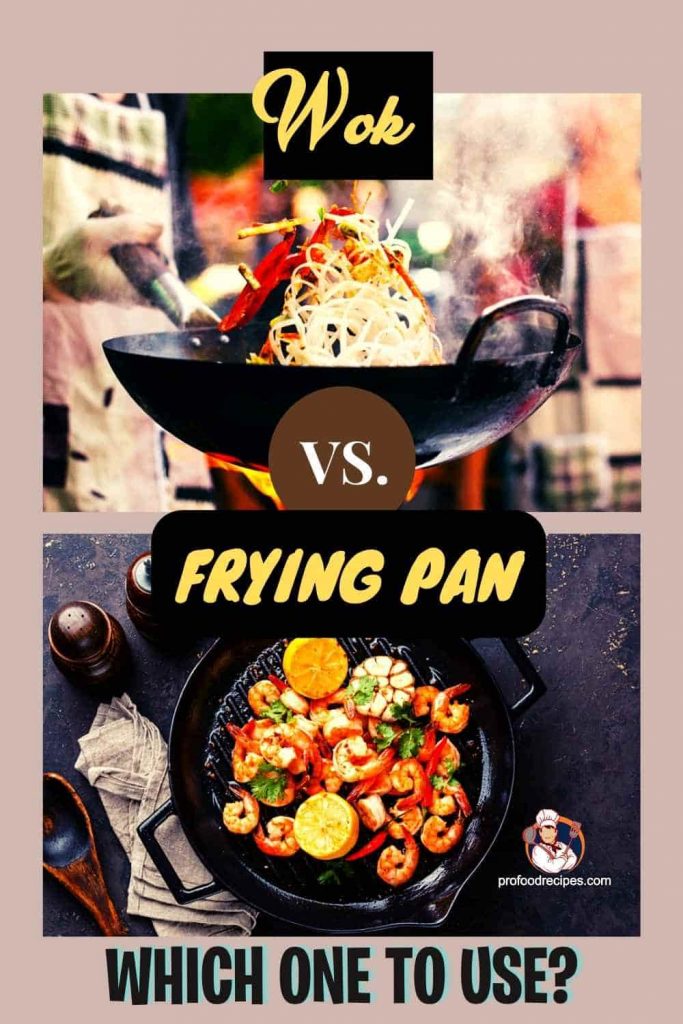
What Is Wok?
Table of Contents
A wok is a Chinese-originated cooking pan with a convex bottom made of metallic elements, usually carbon steel. Various cooking methods, including braising, frying, steaming, etc., benefit from its versatility.
Its unique shape makes it more relevant to serve versatile purposes. This traditional vessel doesn’t let the food spread but keeps it in the center. Moreover, its high, sloping walls also hold heat for longer. Thus, food ingredients catch whole heat fast and lead to fast cooking.
However, blue carbon steel woks are light in weight and more durable than other metal woks. The sloppy surface of these wok acts like non-stick cookware when adequately seasoned.
Also, they have a separate handle that remains cool during cooking. So, you can grip the handle and quickly move and tilt the pan at the stir-frying moment.
What is Wok Made of?
Wok means a metallic cooking vessel simply. There are many materials available that are used for making wok. Carbon steel, aluminum, iron, stainless steel, ceramic, hardened steel, etc. But carbon steel is best among them, considering its durability, non-stick feature, and ease of handling.
What Are the Types of Wok?
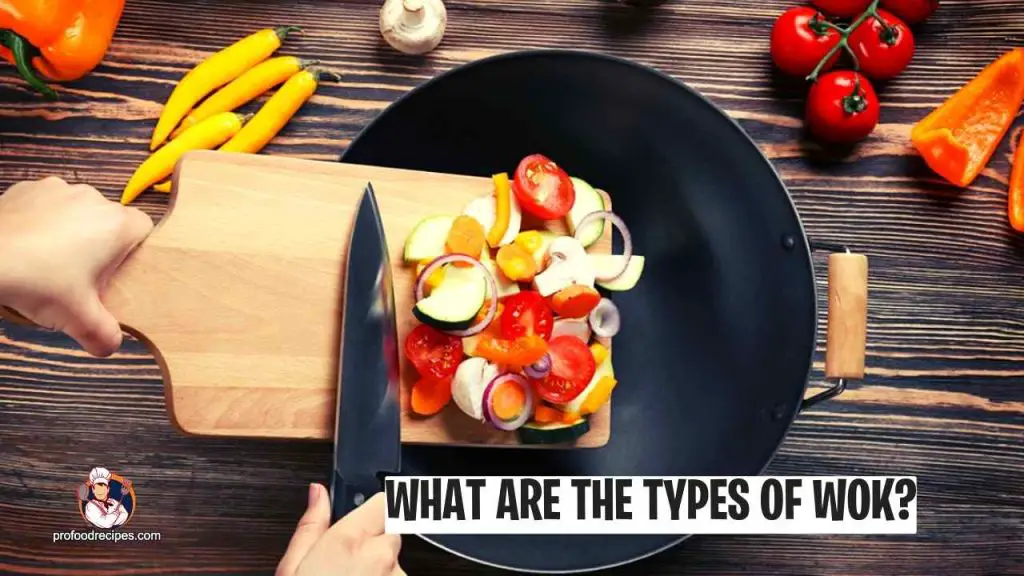
The marketplace offers a wide variety of woks for your cooking needs. Woks can be classified depending on the material, base shape, wok handles, and manufacturing techniques.
6 Types of Wok Based on Materials
1. Stainless Steel Woks
Woks made of stainless steel are durable woks that resemble a professional appearance. It comes with less porous than carbon steel or cast steel. Moreover, naturally, stainless steel woks feature a smooth surface. This smooth surface makes cleaning easy.
Therefore, if you have this type of steel Woks in your kitchen, you will be worry-free about their cleaning. However, stainless steel distributes heat slower than other metals but efficiently distributes heat across the whole wok pan.
2. Carbon Steel Woks
The most wanted and popular woks in woks Bazar are carbon steel woks. Its attractive low price and heat conduction process make it unique. No substitutes are available for carbon steel woks.
Proficient Asian cooks give these woks the most priority as it helps to cook fast and evenly distribute the heat with durability. Moreover, it offers a good season without sticking food on the surface.
3. Cast Iron Woks
Cast iron is one of the durable cookware materials that is adept at holding heat for a long time. Once it is heated, remaining hot for longer and saves energy. Its unique features make it more seasoned as time pass. As its ages, instead of losing the non-stick quality, it gains more.
4. Ceramic Woks
Ceramic woks are one of the safest cookware at high temperatures. It is preferable to traditional Teflon non-stick pans and pots. These woks are made with two main elements of silicon dioxide.
The ceramic coating makes it PTFE and PFO-free as well as heavy metals-free. However, its handling should be careful as it tends to break easily.
5. Aluminum Woks
Aluminum wok acts like an excellent heat conductor. Its unique thermal conductivity feature makes it different from others. It absorbs the heat and evenly disperses it over the entire surface.
Including good conductivity, the aluminum wok demands only a little cost and provides more durability. Moreover, it is lightweight, so easy to handle or carry.
6. Hardened Steel Woks
Hardened steel woks are lightweight and non-responsive wok. It is a less rusted and more durable than a regular steel wok. Hardened steel is harder and strength’s version of ordinary steel.
Read More: How to Cook With Stainless Steel Cookware?
2 Types of Wok Based on Shapes
1. Round Bottom Wok
This type of wok’s bottom is rounded. Usually, traditional wok starts the first journey with a round base. Even people typically know a wok as a pot with a round concave bottom.
2. Flat Bottom Wok
This type of wok consists of a flat bottom. This version of the wok is less old than a round-bottom wok. Many people prefer this version for their electric stoves.
2 Types of Wok Based on Handles
1. Cantonese Woks
Both of the handles of these woks are designed like the letter U. The handles have riveted on both sides of the wok wall’s top part. When you stir food, the handles will help you to get a grip on the wok.
2. Mandarin Woks
They comprise a long mandarin-style metal or wooden handle. The handle may remain in the wok’s either or both sides. Mostly small woks carry this type of handle. Using these woks will be helpful to you to flip dishes.
2 Types of Wok Based on Manufacturing Techniques
1. Hand Hammered Woks
Hand-hammered woks are traditional woks made by hand hammering from a single material sheet. The process makes the wok too hard and durable. Mainly hand-hammered woks are found in carbon steel, iron, or cast iron.
2. POW Woks
POW woks are Chinese chefs’ favorite woks. The woks are usually carbon steel material and comprise a long handle of 6-8 inches. They are easy to handle and flip food. Even you will get an iconic-wok flavor into your food. POW’s handles are available in both mandarin and Cantonese styles
2 Types of Wok Based on Heat Gain Source
1. Regular (Non-Electric) Wok
Gas stove and the flame are needed for normal regular woks to cook food. They are ordinarily metallic vessels.
2. Electric Wok
Electric wok is a new and modern version of the traditional Asian wok. It doesn’t require any gas stove as you can directly connect it to electricity to get heat.
What is Wok Used for?
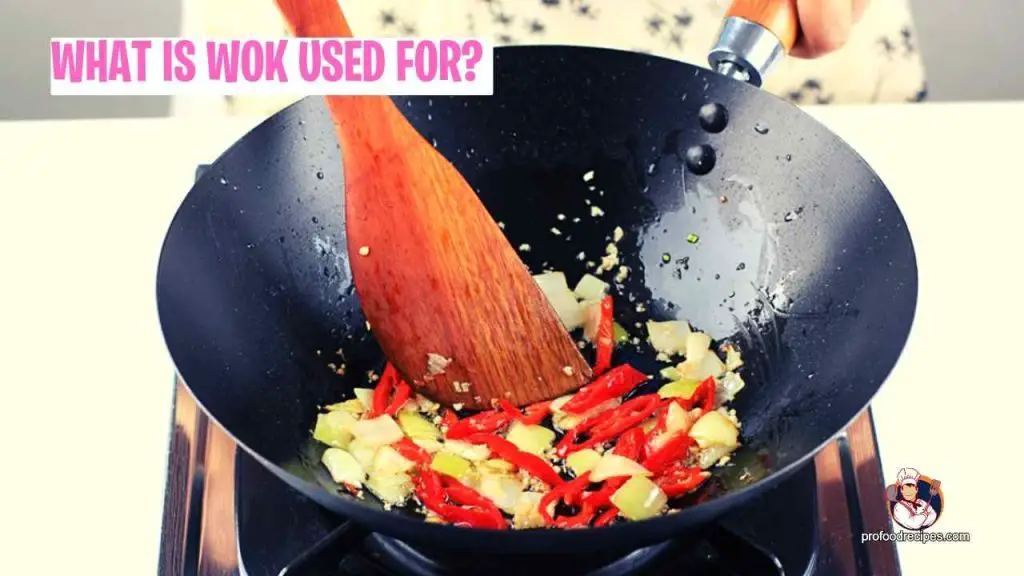
Steaming In A Wok
Wrap your food and shape it as a ball in Aluminum foil paper. Then, put the balls in the wok and pour water. Next, just heat up. Your food will properly steam.
You Can Smoke
A wok is a responsive utensil to heat any food to its smoking point quickly and easily. Moreover, sensitive to alternation in heat out. So, it’s pretty easy to control the quantity of smoke produced.
Deep Frying in a Wok
The food that makes you need deep frying, a wok is a wise choice. A wok can do it for you only in 30% less oil than other cooking vessels.
Stir-Frying
The wok is made to get an ideal stir-frying. In China and worldwide, many professional cookers prefer wok for their regular food’s stir-frying.
Frying Soft Vegetables
Stir-frying is one of the best cooking techniques. This quick and easy cooking process is healthy too. Rather than boil, you can get more nutrients by frying soft vegetables. Even it will provide a crispy and tasty flavor of vegetables.
Frying Steaks and Chops
A wok is always an ideal cooking vessel for whatever food you want to fry. Just pour oil and set high heat to the wok bottom. Next, drop your steak and chops. Fry them until the brown color reveal.
Why Use a Wok?
The primary purpose of wok is stir-frying. The heating process towards your food, wok handle it excellently. Its incredible shape leads to perfect cooking, requiring less oil.
Your food will even get the temperature and cooked overall perfectly. The non-stick surface returns you to a brownie crispy frying food even in high heat. For healthy frying foods (less oily), a wok is one of the best cooking vessels.
What is a Frying Pan?
A frying pan is a multipurpose cooking vessel used for searing, steaming, braising, frying, and many other methods of preparation. It originated in the 3rd century, according to many sources. And So far, all kitchens (home to the restaurant) have a special place for them.
Usually, a frying pan is made with metallic components and consists of a handle to stir. A frying pan can stir and fry your favorite foods together quickly.
What is a Frying Pan Made of?
A frying pan is a metallic cooking vessel that is a regular partner for almost every kitchen. Fry pans can be crafted from a wide variety of materials. These are cast iron, aluminum, carbon steel, stainless steel, Hard-Anodized, ceramic, etc. Mostly, people prefer carbon steel frying pan and cast iron frying pan home to a restaurant.
What Are the Types of Frying Pans?
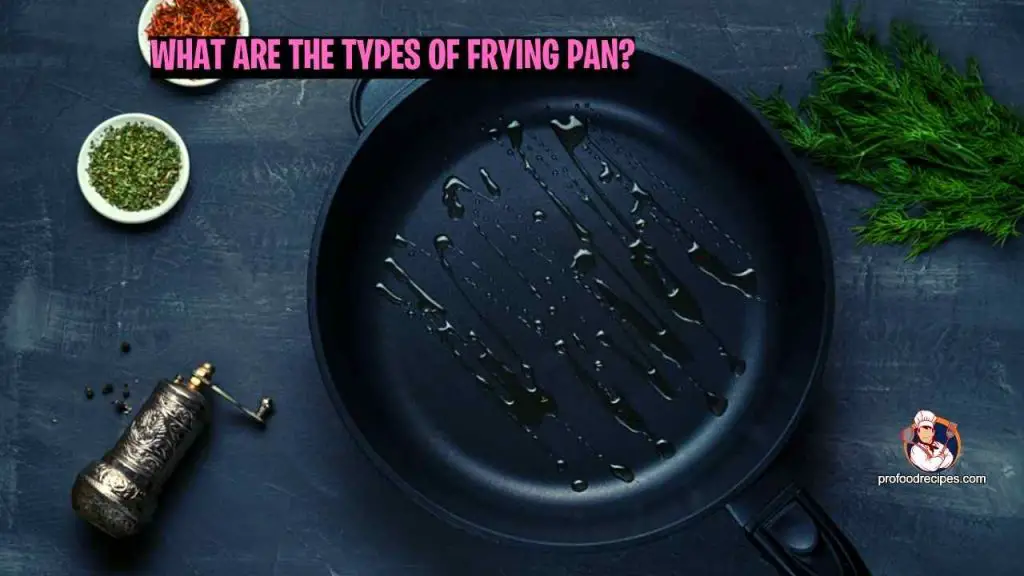
The frying pan resembles a metallic pan used for frying and stirring foods. Some only frying pan types are given below.
6 Types of Frying Pan Based on Materials
1. Non-Stick Frying Pan
The food that has the feature of sticking at the cooking time to fry, the non-stick frying pan is a wise choice. These pans contain an Interior coating (PTFE or Teflon) that helps stabilize their non-stick feature.
Moreover, they are light-weighted and heat up quickly. At low temperatures, they give you the best result than at high temperatures. So, these types of pans are ideal frying pans for foods that require low or medium heat (pancakes, fish, crepes, or eggs).
2. Ceramic Frying Pan
The ceramic frying pan’s coating comprises silica gel made from ceramic stone or sand. They are also similar to non-stick pans and light-weighted. Even they are safe for frying (as ceramics are non-reactive to chemical additives). Avoid metallic spoons or other utensils with these pans, as ceramics tend to break easily.
3. Hard-Anodized Frying Pan
Hard-anodized frying pan’s main component is aluminum. The purpose of aluminum used is to increase durability and make it harder. Though hard-anodized frying pans contain aluminum, they rust and corrode less than the regular aluminum pan. Even the pan’s metallic elements are non-reactive.
So, there is no chance of mixing tiny bits of metal into your food. Thus, the pan secures your health and gives you safe food. Moreover, it does its work smoothly even at high temperatures.
4. Stainless Steel Frying Pan
Stainless steel frying pans are generally a little heavier, but durability is an excessive feature. Applications requiring quick temperature changes are not a suitable fit for stainless steel. So, stainless steel frying pan consists of another material, too, such as aluminum. The pan’s middle part consists of aluminum, and the other two extreme sides comprise two layers of stainless steel. However, stainless pans cook food more evenly, but getting stuck is a general problem.
5. Cast Iron Frying Pan
Cast iron started its journey in the 7th century as a Chinese culinary vessel. It comprises a beautiful enamel coating that leads the cooking without any season. Even it reduces cleaning hassle. Moreover, this coated pan doesn’t let the iron leach into foods. They are exclusive for frying or browning foods, even at high temperatures. This pan will fulfill your non-stick pan needs ideally.
6. Carbon Steel Frying Pan
Carbon steel frying pans are light in weight and thinner than cast iron pans. So, they warm up in a short while. The fast it gains the heat, the fast it loses. However, the perfect season can make it a non-stick one. Its heat distribution process is also excellent and safe. However, without scheduled cleaning, they quickly corrode and rust.
Read More: Is Non Stick Cookware Safe?
2 Types of Frying Pan Based on Riveted Availability
Riveted Frying Pan
These frying pans are riveted. They are permanently attached, and the handles are the sturdiest. But there is a chance of food getting stuck, which can increase your cleaning hassle.
Rivetless Frying Pan
The rivet-less frying pan is a smooth, surfaced pan that makes cooking easier. Even no chance to stuck food on the rivet. These frying pans are too durable and robust.
2 Types of Frying Pan Based on Heat Gain Source
Non-Stick Frying Pan (Non-Electric)
This non-stick pan is used for cooking on a gas stove. Usually, they are made of metal. So, you can cook food with them on a gas stove. These metallic pans quickly absorb heat and distribute it across the bottom.
Electric Frying Pan
These pans complete cooking getting heat from electricity. It has a plug you need to connect to the electric port, and it will start and do your cooking fast. Many people love this version for their cooking.
Read More: Is Stainless Steel Cookware Toxic?
Without the above classifications, you can find differences or many types of frying pans based on size, shape, and thickness. However, according to your demand (what you will cook, the number of your family), you can choose the size and shape. I will say about thickness, as much as thick will be your frying pan as much as durability will be. Even a thicker pan lasts long.
What is the Frying Pan Used for?
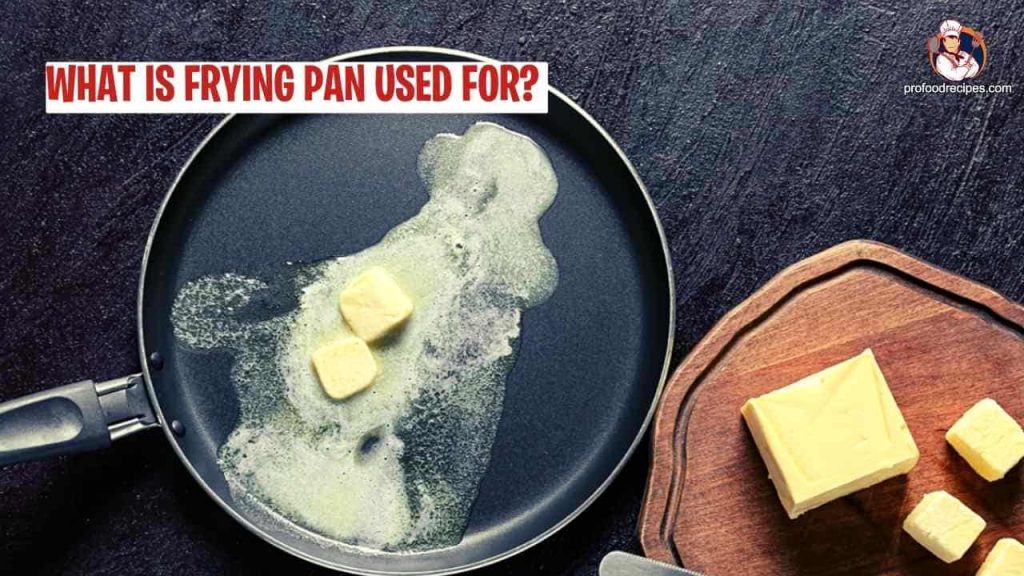
Frying-Stirring
You can fry foods on a frying pan. Vegetables and meats will form a crispy taste.
Searing Foods
Searing food, especially searing meat, demand a frying pan for the best result.
Browning Foods
For browning foods frying pan is a large cooking vessel. Put some oil and heat your pan, then fry your food until it gets a brown shade.
Steaming Foods
You can steam foods in a frying pan smoothly. Just pour water into the pan and then put food. Cover the pan and let them steam.
Why Use a Frying Pan?
A frying pan is designed mainly for stirring-frying. This lightweight pan is easy to handle. You can smoothly stir food with its handle. You can observe the food clearly since the food in the pan is not stacked in one place.
You can welcome this frying pan for Low-heated food such as pancakes. Moreover, browning, seasoning, and frying – are all you can smoothly do with this pan.
Read More: How to Cook Turkey Fillets in a Pan?
Wok vs Frying Pan
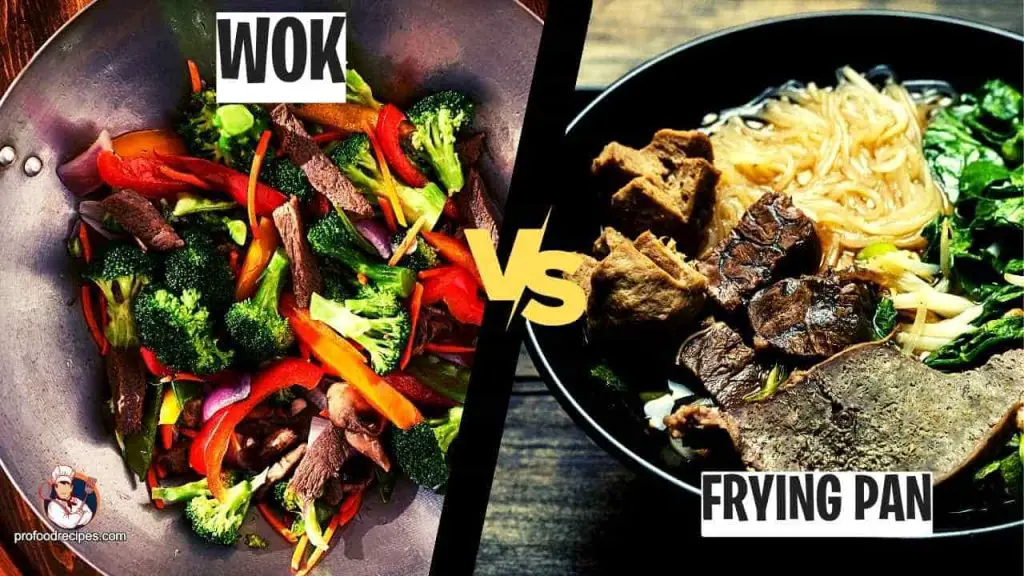
Design and Shape
Concave-bottom is for the wok, and Flat-bottom is for the frying pan. Wok’s wall is highly sloppy, and the frying pan’s wall is less sloppy than wok’s. That’s why food remains at the center of woks. And the food in the frying pan sits evenly on the whole bottom of the pan.
Handle
They both come with a handle. Wok usually comes with a two-sided small metallic or wooden handle, and frying pans typically comprise a single handle.
Fast Cooking
A wok offers quick cuisine than a frying pan.
Consider Health
a wok’s comparably a healthy cooking vessel and returns healthy foods in less oil.
Heat Responsiveness
Woks provide the best service even in high heat compared to the frying pan. (But you may need to stir the food while your food is in a wok. Otherwise, it may burn your food.). For low-heated food such as pancakes or soft vegetables, a frying pan is an ideal option than Woks.
Constantly Stirred Food
Whenever you are cooking such food that needs constantly stir or high heat, the wok is perfectly fit for them than a frying pan.
Searing Meat
For searing meat, a frying pan will be a great partner than a wok. Without the above differences, some features are the same such as materials (mostly carbon steel) and non-stick cooking vessels, and both are used for stir-frying.
Which is Better, a Wok or a Frying pan?
The wok and frying pan are both used for stir-frying generally. Most people, even cooking experts, admire woks more than a frying pan. Some consider facts that inspire them to take it as their favorite and best option. These facts are fast cooking, healthy cooking vessels (less oil required), high heat performance, and fit more food at once.
However, a frying pan is preferable for some food that requires low heat and searing steak or meat.
When is It Better to Use a Wok Than a Pan?
The wok is designed in a special shape considering for constantly stirring food. It gives excellent results in high temperatures. So, when you need fast cooking and frying with less oil, aside the frying pan and take the wok to do it. You will benefit, sure. (Just keep stirring food to avoid burning)
When Should You Use a Regular Pan Instead of a Wok?
The frying pan and wok’s primary purpose is stir-frying. But they carry some different services too. A frying pan is a little forwarded than a wok for cooking soft foods, vegetables, and fragile meats.
Moreover, searing meat in a frying pan is more appropriate than a wok. This does not imply that wok cannot offer these facilities. But the better result you will gain from the frying pan.
What Recipes Require a Wok?
There are several delicious recipes available that you can cook in a wok. Some great of them are mentioned here.
· Beef and Broccoli
· Vegetable Stir-fry
· Dan Dan Noodles
· Garlic Shrimp Stir-fry
· Yakisoba Chicken
· Pad Thai
· Cabbage Stir-fry
· Chicken Eggplant With Garlic Sauce and So More.
What Recipes Require a Frying Pan?
You can make many good table-maker dishes with your regular cooking vessel frying pan. Below are some delicious options for pan-fried meals.
· Meatball and Zucchini Noodles
· One-pan Caprese Chicken
· Spicy Tomato and Capsicum Meatball Shakshuka
· Frying Pan Chicken Lasagna
· Corn and Chorizo Zucchini Slice
· Zucchini and Egg Rice Pie
· Pea and Ricotta Spaghetti With Gremolata
Is There a Difference in Cooking Using a Wok?
Yes, compared to other cooking vessels, the wok will give a magical touch to your food. Its exceptional shape leads it to make properly cooked food in less oil. It balances the health and taste of your food.
Can You Use the Wok on an Electric Stove?
Yes, but your wok bottom should be flat type. Otherwise, a regularly rounded wok in an electric stove will not be an ideal cooking vessel. A flat-bottom wok may not be a good heat conductor like a round one. But considering an electric stove, a flat one is preferable.
Can a Wok Be Used for All Cooking Purposes?
Yes, almost everything you can cook in your versatile wok. You can get this versatile cooking saucepan as a great partner for many purposes steaming to -frying and browning (all). A wok can be an alternative vessel to many other types of vessels.
Does a Wok Have a Lid?
Yes, and this fantastic lid plays an essential role in wok cooking. It will make your cooking smooth, especially during Chinese food cooking time. A wok’s lid will be your excellent partner when your food needs to simmer or cover food for other purposes.
What Size Wok is the Best?
Woks have various sizes from 10 inches to 20 inches in the US. Now, according to your demand, your family member’s number, and at one time how amount food you want to cook will decide which one is appropriate for your cooking. Generally, maximum users prefer a 14-inch wok, mainly for 2 to 5 people.
Why Do Stainless Steel Pans Smell?
Stainless steel metal reacts with oil while you are cooking. Then it emits a smell. Moreover, it can react with a gas flame and create different oxides. Besides, if you cook food on this non-stick pan over a temperature (of 500F), the coating may be hampered and smell out.
How Can a Frying Pan’s Quality Be Determined?
By following the below steps, you can pick a good frying pan. Check-
1. Durability and non-stick feature
2. Heat distribution
3. Cookware oven’s safety
4. Warranty
5. Easy to clean or not
6. The size and type of frying pan (according to your lifestyle and demand).
Final Verdict
I hope you know what wok and frying are, their uses, what types are available, what they are made of, their services, etc. Even you have learned about Wok vs Frying Pan. It should be clear to you now which one is the greatest option for you and your kitchen. Choose the best alternative.
However, a frying pan and a wok are best for their purposes. But I go with a wok. It seems a more versatile and healthy cooking vessel to me than others.
You May Also Like to Read:
- How to Care for Stainless Steel Cookware?
- How to Clean Copper Cookware?
- Things You Need to Know about Instant Pot
